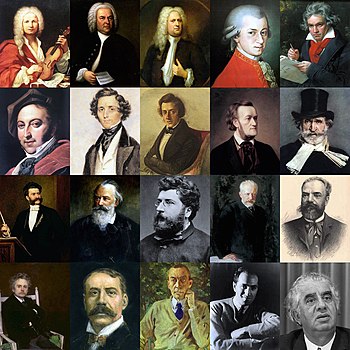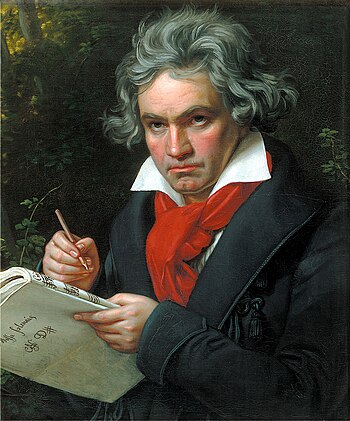Music in XVIII century (1600-1825)
There were two times in this century. The first era was called the baroque era. This era was around 1600 to 1750. Baroque was the beginning of modern music because it has experienced the revolution from both theory and technique of its cultivating.
There were two times in this century. The first era was called the baroque era. This era was around 1600 to 1750. Baroque was the beginning of modern music because it has experienced the revolution from both theory and technique of its cultivating.
The key characteristics of this era included the merger of major and minor scales, many dissonan tones, the development of the orchestra, and the regular structures, but monotony. They also included the use of violin, harpsichord, organ, and flute.
 |
Montage of great classical music composers - from left to right: first row - Antonio Vivaldi, Johann Sebastian Bach, Georg Friedrich Händel, Wolfgang Amadeus Mozart, Ludwig van Beethoven; second row - Gioachino Rossini, Felix Mendelssohn, Frédéric Chopin, Richard Wagner, Giuseppe Verdi; third row - Johann Strauss II, Johannes Brahms, Georges Bizet, Pyotr Ilyich Tchaikovsky, Antonín Dvořák; forth row - Edvard Grieg, Edward Elgar, Sergei Rachmaninoff, George Gershwin, Aram Khachaturian (Photo credit: Wikipedia) |
In this era, people also knew basso continuo technique, namely the bass accompaniment that brought harmony. There was repetition in the structure of music.
Composers who lived in this era were Johann Sebastian Bach, Georg Friedrich Handel, Antonio Vivaldi, Claudio Monteverdi, and Henry Purcell.
The second era was called the classical era. Sonatas and chamber music grew with more dynamic melodies. All of the classical era rules were applied intelligently by the composers.
The key characteristics of this era were the development of musical harmony, a very strong element of the dynamics that colored the composition, and a dynamic atmosphere that was expressed through the tempo, melody, and harmony. In this era, people also knew the pattern of 'question and answer'. Piano, with its ability to create dynamic, became a very important instrument.
The popular composers in this era were Wolfgang Amadeus Mozart, Franz Joseph Haydn, and John Gay.
 |
|
|
Transition period of Ludwig van Beethoven (1770-1827)
This period represented the transition time from classical music to romantic music that was initiated by Beethoven. He brought a dynamic element by using wider harmonies and more emotional techniques of music cultivating.
This period was called as transitional because there were some principles of classical era that were violated by Beethoven. For example: the use of the intro was considered to be the outside of the classical composition theory. However, it was precisely a characteristic of romantic music. Through his works, Beethoven influenced the transition of classical to romantic music greatly.
Article Source: EzineArticles
|

No comments:
Post a Comment